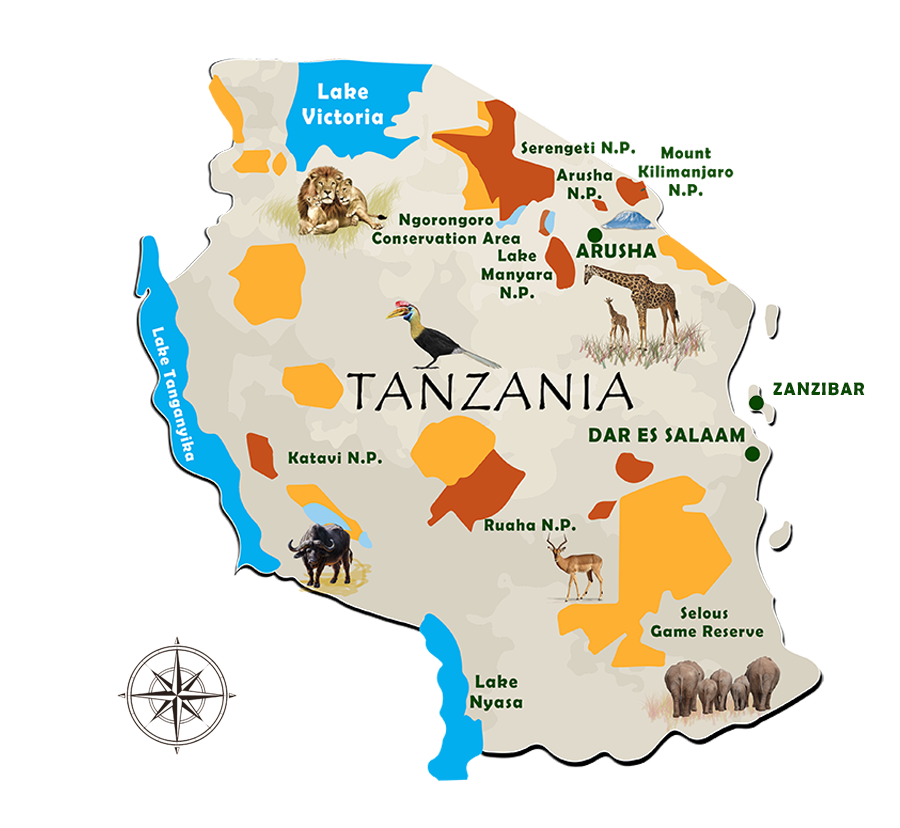
Serengeti National Park is undoubtedly the best-known wildlife sanctuary in the world, unequalled for its natural beauty and scientific value, it has the greatest concentration of plains game in Africa.
The Serengeti National Park in Tanzania was established in 1952. It is home to the greatest wildlife spectacle on earth – the great migration of wildebeest and zebra. And that has been a opulent factor for world’s best game viewing reserve. Not to mention the big five. And why not? Apart from wildebeest and zebra, Serengeti homes half a million Thomson’s and Grant’s gazelle, and tens of thousands of topi and Coke’s hartebeest. Also, Masai giraffe, waterbuck, impala, warthog, hippo and some rare species like common eland, klipspringer, roan antelope, bushbuck, lesser kudu, fringe-eared oryx and dik dik add to the wild entertaining games. The vastness of the park only adds richness and it’s larger than Connecticut, with at most a couple hundred vehicles driving around.
The Park can be divided into 3 sections. The popular southern/central part (Seronera Valley), is what the Maasai called the “serengit”, the land of endless plains. It’s classic savannah, dotted with acacias and filled with wildlife. The western corridor is covered with the black clay soil savannah. The Grumeti River and the forest covered passage in this region provides home to Nile crocodiles, patas monkeys, hippopotamus, and martial eagles. And the northern Serengeti is a landscape is dominated by open woodlands and hills, where you will find the migratory wildebeest and zebra from July to August, and in November. But is a home for elephant, giraffe, and dik dik which are frequently seen.
Two World Heritage Sites and two Biosphere Reserves have been established within the 30,000 km² region. It’s unique ecosystem has inspired writers from Ernest Hemingway to Peter Mattheissen, filmakers like Hugo von Lawick and Alan Root as well as numerous photographers and scientists – many of which have put their works at our disposal to create this website.
The Serengeti ecosystem is one of the oldest on earth. It homes over 3,000 lions, 1,000 leopards, and 7,700 to 8,700 spotted hyenas along with a diversity of grazers. The bimodal rain pattern makes safari seekers to be scrupulous. As November and December with short rains do tend to attract visitors, March to May is definitely not recommended as they are heavy wet seasons. The park is abundant of rich wildlife and high biodiversity.
However, safari guides are experienced enough to take you through smart routes and efficient camps to view the Lion King’s kingdom in its full glory. Apart from migration, it stood out for its game viewing kick. So, you may ask what you will be experiencing in a particular period of the year. You definitely don’t want to miss why Serengeti is called one of the Seven Natural Wonders of Africa. Would you?
Still, the word that brings Serengeti into headlines is migration though. Wildebeest migration to be exact that tends to follow through the park, reserves and protected areas and through a variety of habitat. Join us to explore the different forms of vegetation and landscapes of the Serengeti ecosystem and meet some of their most fascinating inhabitants.


As dedicated travel specialists, we are here to help you plan the perfect trip. We're with you from the beginning, during the crucial planning stages, throughout your trip in case anything comes up, and afterwards to make sure everything went perfectly. If anything were to go wrong during your trip, we are here for you.
While we have sample itineraries to help you create the perfect trip, we encourage you to travel at your own pace with a custom itinerary - or simply book accommodation and excursions to travel with full flexibility. We also give you access to an amazing product line that would be very difficult to find otherwise.
Our trips beneficial for local communities through a variety of environmental, and cultural initiatives. All our partners have been upholding a level of service that we truly stand behind. We strive to work with like-minded partners who are committed to making sure tourism doesn't have a negative impact on destinations.